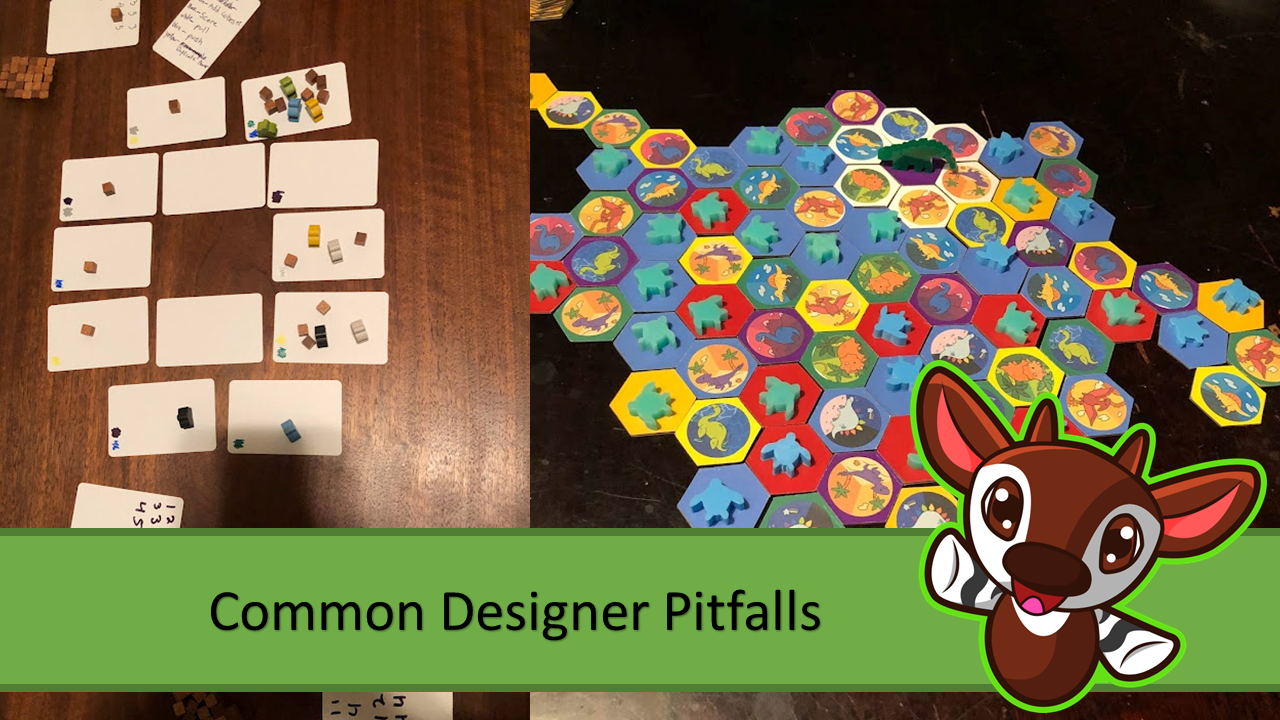
There are a few things that designers might run into when they start working on games. These issues can plague any designer, but the first step to making sure you don’t allow them to get in your way is knowing that they exist in the first place. Be wary of falling into the following traps…
Focusing on Perfection vs Improvement
The more time you take to make your prototype completely perfect, the more time you could potentially be wasting by going in the wrong direction with your design. When I first started designing, I wanted everything to be perfect before I playtested, including the iconography, card layout, and game balance. However, once I made everything perfect, I’d get the game to the table and notice an issue with something within a few turns of the game. You can learn a lot by getting an idea to the table as fast as possible, just so you know what aspects you’re going to keep and which you’re not, then you can spend more time making things clear and easy to understand for outside playtesters.
Not Preparing Enough for Playtesting
I’ve noticed that a lot of designers don’t know the exact reason why they’re playtesting at the start of the playtest. You should always have a goal when you playtest, whether it’s to test out a certain number of players, a certain strategy, or something else entirely. Having a specific series of questions in mind before the playtest starts is great too! This way, you can get the most value out of every playtest, and you’ll make sure to get the right kind of playtesters and prep them appropriately. Letting your playtesters know why you’re playtesting allows them to take notice of things during the playtest, and allows you to get better insights into their thoughts.
You can learn more about playtesting goals in this blog post.
Getting Too Emotional
Designers who get too emotional during playtesting usually don’t get great feedback on their games. Playtesters can see when you react poorly to their thoughts, and it will shut them down. You’ll miss a lot of feedback if you don’t make playtesting a safe space for playtesters to say what they think. Even explaining why you designed things a certain way can make it seem like you don’t want to hear from playtesters.
Learning how to distance yourself from feedback will make you a better designer. You’ll be able to get all the feedback you can from playtesters and will hopefully also help you playtest in the future! I’ve had plenty of playtesters message me after a playtest with more information and thoughts they had after a playtest simply because I try to stay calm and listen to what everyone has to say without dominating the conversation.
Spending a Lot of Money
Some designers get really excited about their game. That’s great! However, if you spend a lot of money on your game in the early stages, you might spend more than you’d like over the course of the design process. I’ve known designers that get a new print-on-demand copy of their game for every iteration, which can take time getting the files in the right format, uploading them, and waiting for shipping.
I do recommend getting a fancy prototype of your game made every so often, as it can be a great motivator to see a ‘real’ copy of your game, but there’s no need to do so for most iterations.
I would also recommend against commissioning illustration or graphic design for your game unless you’re planning on publishing the game. Even then, I’d recommend waiting until the game is really close to done and you’re happy with the main mechanisms and how the game works. If you commission art before you’ve finalized a lot of the gameplay, you could end up having to redo artwork or commission more pieces than you were expecting to, and other pieces may be lost as you cut components out.
It is occasionally nice to get an illustration or official logo made for your game, as it can be inspirational to see your design as more “real,” but make sure you don’t go too far, as game design generally isn’t a particularly lucrative field and you can easily spend money you don’t have.
Not Interacting with the Community
The board game design community is amazing and can be super helpful if you’re willing to interact with people and give them the time of day. You can do this in person, sure, but you can also participate in Facebook groups, the Twitter community, or elsewhere. Not only can you find people to playtest your games, but you can also find people to help proofread your rules, talk about your ideas, or simply support you. Whether you prefer a local or online community, interacting on a regular basis can keep you motivated and in the loop for different opportunities.
If I had not talked with different designers, I wouldn’t have been invited to go to various game retreats or told about interesting conventions. I also would have never been able to work with the number of codesigners I have or learned so much about design and the industry.
Being part of the game design community is rewarding on multiple levels and making sure to participate and give back to the community can make the difference in having your game published or not.
Did you enjoy this entry? Can you think of any small changes that can make your life better? Please let me know! I’d love to hear what you think and what kind of things you’d like to see from this blog. Feel free to send me an email or comment with your thoughts!
Don’t forget to sign up for my mailing list, so you don’t miss a post: https://tinyletter.com/carlakopp
excellent points carla!